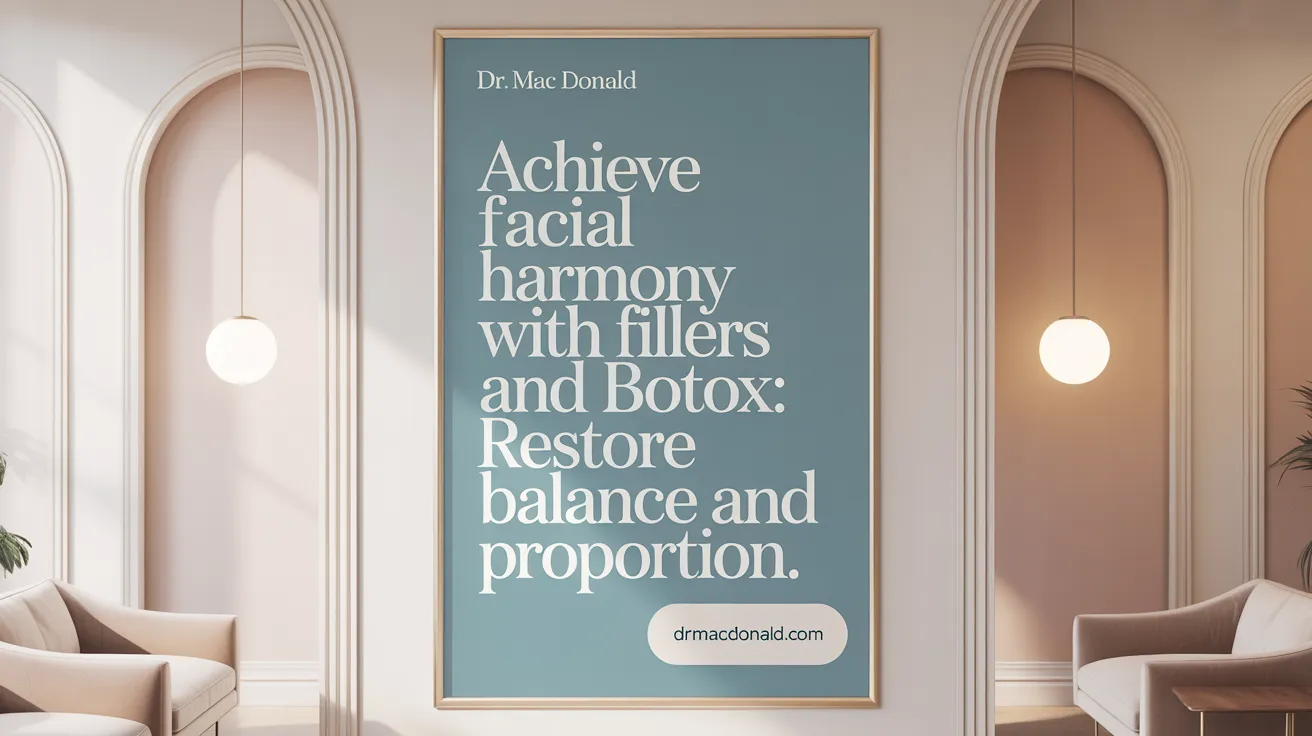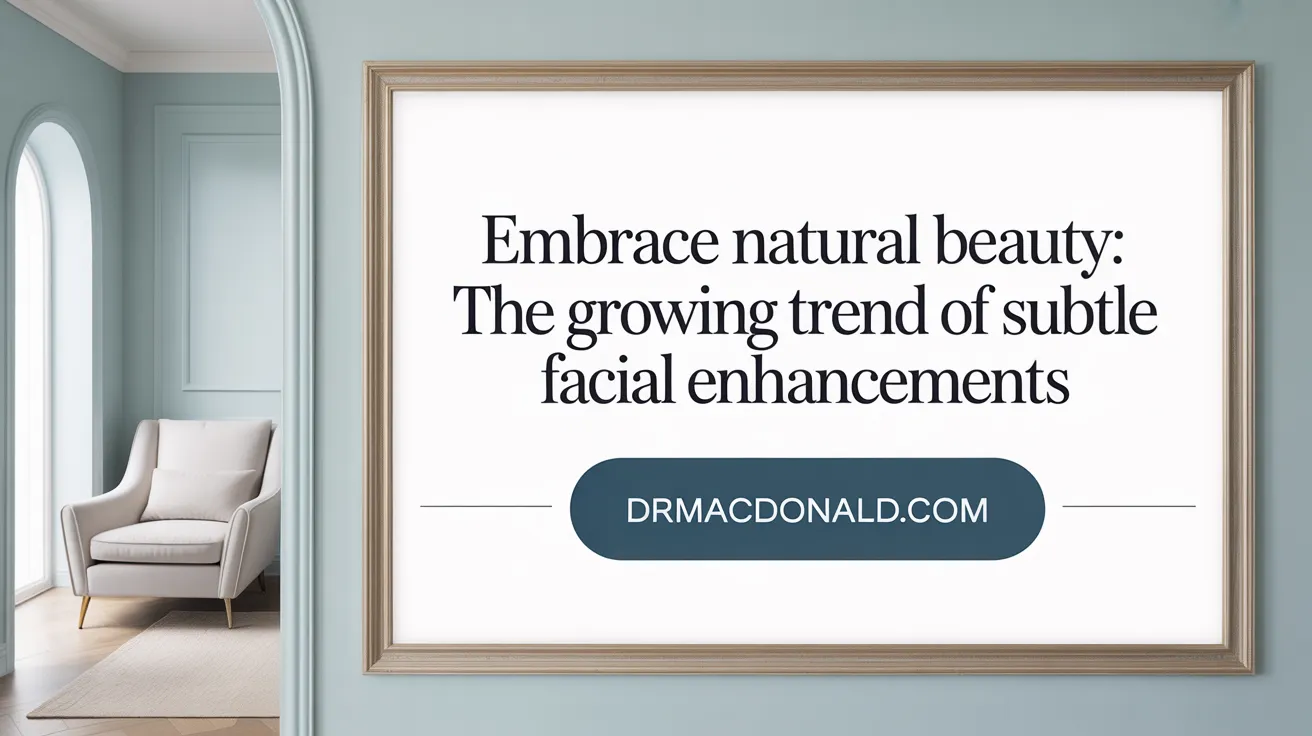Understanding the Essence of Facial Balancing
Facial balancing has emerged as a transformative approach in cosmetic aesthetics, shifting focus from drastic alterations to subtle, personalized enhancements. This holistic technique emphasizes harmony, proportion, and natural beauty, aiming to enhance how facial features interact collectively rather than focusing on isolated flaws. By tailoring treatments to an individual's unique facial structure, facial balancing offers an artful pathway to a refreshed, balanced, and youthful appearance without compromising authenticity.
A Holistic Approach: The Philosophy Behind Facial Balancing
What is Facial Balancing?
Facial balancing is an aesthetic approach that focuses on enhancing the natural harmony and proportion of a person's face. Instead of targeting one feature alone, this method considers the entire face to create balance and improve overall attractiveness.
What is the Goal of Facial Balancing?
The primary goal is to subtly enhance or soften facial features to achieve a more proportionate and naturally attractive appearance. Facial balancing aims for harmony and symmetry rather than making drastic changes or pursuing perfection.
How is Full-Face Assessment Used?
Practitioners conduct a detailed, full-face assessment examining the relationships between features such as the nose, chin, cheeks, and lips. This comprehensive evaluation ensures treatments complement each other and work together to improve facial harmony.
Why is Individualized Treatment Planning Important?
Every face is unique, and facial balancing involves personalized treatment plans tailored to individual features, goals, and comfort levels. These plans combine surgical and nonsurgical options, depending on the patient’s needs.
Why Emphasize Natural Enhancements?
The philosophy of facial balancing focuses on natural-looking results that respect the patient’s identity. Instead of dramatic changes, the approach prioritizes subtle enhancements that preserve one’s individual beauty and create a refreshed, balanced appearance.
Techniques and Treatments: Combining Surgical and Nonsurgical Options
What surgical options are used in facial balancing?
Surgical treatments in facial balancing primarily include facial implants and facelifts, rhinoplasty for facial symmetry, and chin implants for jawline balance. These procedures address more pronounced structural concerns and age-related laxity. For example, rhinoplasty refines nasal contours, while chin implants enhance lower facial harmony. Facelifts and skin-tightening surgeries restore youthful firmness. Surgical approaches often require anesthesia and longer recovery periods but offer lasting, transformative results.
What nonsurgical options complement surgical techniques?
Nonsurgical treatments play a vital role in facial balancing by providing subtle enhancements with minimal downtime. Hyaluronic acid fillers restore volume and improve contour in areas such as cheeks, chin, jawline, nose, lips, temples, and under the eyes. Bioidentical fat mimetics like Renuva offer soft, natural fullness mimicking fat tissue. Neurotoxins, including Botox, relax overactive muscles, smooth wrinkles, and subtly lift features, enhancing symmetry without surgery.
How is treatment customized to patient goals?
Facial balancing is highly individualized, involving a collaborative consultation between surgeon and patient. The treatment plan is tailored to the person’s unique facial anatomy, aesthetic goals, and comfort level. Surgeons analyze the relationships among various features—nose, chin, cheeks, jawline—to decide the most effective combination and sequence of treatments. This ensures balanced, natural-looking results rather than drastic alterations.
What treatment areas are commonly addressed?
Commonly treated areas include the cheeks to add volume, the chin and jawline for definition and symmetry, the nose for proportional refinement, lips for balanced fullness, temples for youthful contouring, and the delicate under-eye region for softening hollows. Each area is addressed in context with others to maintain overall facial harmony.
What are the risks and safety considerations?
Safety is paramount, especially in delicate regions. Under-eye filler treatments carry risks such as vision impairment if injected improperly. Choosing a board-certified plastic surgeon ensures adherence to high safety standards and expertise. Proper technique and anatomical knowledge minimize complications like swelling, lumps, or vascular occlusion in filler injections. Patients are guided on aftercare to support healing and optimal results. Overall, combining surgical and nonsurgical methods offers a versatile, balanced approach customized to individual needs with a focus on safety and natural beauty.
The Role of Dermal Fillers and Neuromodulators in Facial Harmony

How Do Dermal Fillers Contribute to Facial Harmony?
Dermal fillers, predominantly those based on hyaluronic acid fillers like Juvederm and Restylane, play a crucial role in facial balancing procedures by restoring lost volume and correcting asymmetry. By strategically adding volume to areas such as the cheeks, chin, jawline, and lips, fillers enhance facial proportions and contour, creating a more harmonious and youthful appearance.
What Types of Dermal Fillers Are Used?
Besides hyaluronic acid fillers like Juvederm and Restylane, collagen-stimulating injectables such as Radiesse and Sculptra are also employed. These alternatives not only add volume but stimulate collagen production, offering longer-lasting improvements and natural skin rejuvenation.
How Do Neuromodulators Like Botox Work?
Neuromodulators like Dysport and Xeomin, including Botox and its counterparts, relax overactive facial muscles that cause wrinkles and asymmetries. By softening expression lines and lifting specific areas such as brows or mouth corners, they contribute to overall facial symmetry and a refreshed look, as detailed in facial balancing with dermal fillers and Botox.
What Are the Duration and Reversibility of These Treatments?
Most hyaluronic acid fillers last between 9 and 18 months and are reversible, allowing for adjustments if necessary. Neuromodulators typically last about 3 to 4 months, requiring regular maintenance for sustained effect. For more details on longevity and maintenance, see facial balancing overview.
What Are the Benefits and Possible Side Effects?
Benefits include minimally invasive application, immediate and natural-looking results, little to no downtime, and customizable treatments. Common side effects might include mild swelling, bruising, redness, or tenderness that usually resolve quickly, as explained in the guide on healing after facial balancing.
Why Is an Experienced Practitioner Essential?
Due to the delicate facial anatomy, particularly in areas like under the eyes where vascular occlusion in filler injections can be a risk, treatments require expertise to minimize complications such as lumps or more serious issues. Experienced, board-certified professionals ensure safe procedures with aesthetically pleasing, natural outcomes. For patient safety and the best results, choosing a board-certified plastic surgeon is highly recommended.
Safety and Expertise: Ensuring Natural and Secure Results

Why choose a board-certified plastic surgeon?
Selecting a board-certified plastic surgeon is crucial for safety and natural outcomes in facial balancing procedures. These surgeons have completed rigorous training and adhere to ethical and professional standards, ensuring procedures are performed properly and responsibly. Their expertise helps minimize risks and tailor treatments to individual facial anatomy and goals.
What are the risks of filler injections in sensitive areas?
Filler injections, especially around delicate regions like the under-eye area, carry potential risks such as blindness, vascular occlusion in filler injections, contour irregularities, and lumps. These complications mainly arise when injections are misplaced or administered by inexperienced practitioners. Therefore, precision and knowledge of facial anatomy are essential. Learn more about the risks of under-eye filler injections.
Why is proper consultation and individual assessment important?
A thorough consultation is vital to assess overall facial structure, skin quality, medical history, and patient expectations. This individualized evaluation guides the creation of a personalized facial balancing plan that respects natural facial proportions and addresses untreated asymmetries safely.
How do surgeons ensure safe practices and procedural standards?
Surgeons follow strict safety protocols including skin cleansing, use of FDA-approved products, careful injection techniques, and appropriate dosage control. Minimally invasive approaches and sequencing of treatments reduce risks and promote harmonious, lasting results. To understand safety further, see Safety in facial filler injections.
What role does patient education and post-treatment care play?
Patients are educated on post-procedure care like avoiding strenuous activity, not touching treated areas, sleeping with the head elevated, and monitoring for unusual symptoms. Proper aftercare speeds recovery, decreases swelling or bruising, and reinforces treatment effectiveness. For detailed guidance, refer to Healing after facial balancing.
How are complications managed effectively?
Early recognition of adverse effects such as severe pain, discoloration, and vision changes prompts immediate medical attention. Board-certified surgeons are trained to manage complications swiftly, including possible filler reversal and supportive treatments, ensuring patient safety and confidence. Learn more about managing risks at Facial balancing with dermal fillers and Botox.
Maintaining natural and secure facial balancing results depends heavily on expert care, individualized planning, and patient collaboration through every step of the procedure. For a comprehensive overview of Facial balancing procedures, visit the American Society of Plastic Surgeons.
Healing and Aftercare: What to Expect Post-Treatment

What are the typical immediate reactions after facial balancing treatments?
After receiving facial balancing treatments such as dermal fillers, it is common to experience mild swelling, bruising, and tenderness in the treated areas. These reactions typically occur immediately post-procedure but are temporary and part of the normal healing process.
How long does the healing process usually take?
Swelling tends to peak around 2 to 3 days after treatment and gradually subsides over the following week. Minor lumps or firmness under the skin may be noticed within the first week but usually soften as the filler integrates. Full results become more apparent between 2 to 4 weeks post-treatment. For more on healing after facial balancing, see guidance on managing swelling and recovery.
What post-treatment care is recommended?
To promote optimal healing, patients should avoid strenuous activities and refrain from touching or rubbing the treated areas for at least 48 hours. Sleeping with the head elevated helps reduce swelling. Gentle skincare is advised, alongside the use of cold compresses to soothe any discomfort or inflammation. Proper post-treatment care for fillers is essential for best results.
What signs indicate complications?
Patients should be alert for symptoms such as skin discoloration or mottling, severe pain, numbness, persistent redness or warmth, and any changes in vision. These signs require immediate medical attention to prevent serious adverse effects. Awareness of facial filler complications and risks is crucial.
Why is following aftercare instructions important?
Adhering to the recommended post-treatment guidelines ensures proper healing, helps minimize side effects, and maximizes the longevity and natural appearance of facial balancing results. Careful aftercare supports safe recovery and overall patient satisfaction. Learn more about the importance of following post-facial balancing instructions and safety in facial filler injections.
The Cultural Shift: Rising Popularity and the Pursuit of Subtle Beauty

How Has Social Media Influenced Facial Aesthetics?
Social media platforms have played a significant role in popularizing facial balancing procedures. Through widespread sharing of before-and-after photos and tutorial videos, people have become more aware of facial aesthetics and the importance of facial harmony. This has sparked increased interest in procedures that subtly enhance natural features without drastic changes.
Why Is There a Growing Preference for Natural, Authentic Results?
Today’s beauty standards emphasize authenticity and subtlety. Facial balancing aims for harmonious proportions and natural attractiveness rather than dramatic alterations. Patients seek enhancements that preserve their identity and avoid the "overdone" or artificial look often criticized on social media.
How Does Facial Balancing Address Facial Asymmetry and Aging?
Facial asymmetry and signs of aging such as volume loss or tissue laxity are common concerns. Facial balancing treatments restore volume, refine contours, and soften asymmetries using Neuromodulators like Dysport and Xeomin, Collagen-stimulating injectables and Fat mimetics in nonsurgical facial balancing, and surgical approaches, when needed (facial balancing procedures). This holistic approach rejuvenates the entire face, creating youthful and balanced appearances (Facial balancing holistic approach).
Can Facial Balancing Boost Self-Confidence Through Harmony?
Achieving facial harmony can significantly improve self-esteem. When facial features look balanced and proportionate, patients often report feeling more confident and comfortable in their appearance. The personalized nature of facial balancing ensures results that enhance individuality (Facial Balancing Benefits).
What Are the Long-Term Benefits of Facial Balancing?
The customized treatment plans used in facial balancing promote natural aging processes and maintain facial harmony over time. Subtle, balanced enhancements reduce the need for frequent corrections and support a refreshed appearance that evolves gracefully (Using hyaluronic acid fillers, Facial balancing overview.
Who Benefits from Facial Balancing? Patient Demographics and Appeal
Facial balancing has universal appeal across ages, ethnicities, and face types. Both younger individuals seeking to correct minor asymmetries and older patients aiming to counteract aging effects find treatments suitable. The adaptability of facial balancing techniques to diverse features allows broad access and satisfaction (Facial balancing for different ages).
Embracing Subtlety for Timeless Beauty
Facial balancing represents a nuanced evolution in aesthetic medicine, prioritizing the harmony and proportion of features over radical change. This personalized, holistic approach combines artistry and science to enhance natural beauty, promote symmetry, and elevate confidence. Through a range of carefully selected surgical and nonsurgical options, guided by expert hands and safety protocols, patients achieve refreshed yet authentic looks. As society increasingly values subtlety, facial balancing stands as a testament to the power of understated enhancements that honor individuality and foster lasting satisfaction.
